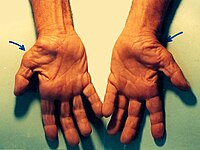
Photo from wikipedia
BACKGROUND Retrospective review of patients with a diagnosis of Tarsal Tunnel Syndrome (TTS) treated surgically. METHODS Retrospective series of patients with diagnosis of TTS operated between 2005 and 2020 in… Click to show full abstract
BACKGROUND Retrospective review of patients with a diagnosis of Tarsal Tunnel Syndrome (TTS) treated surgically. METHODS Retrospective series of patients with diagnosis of TTS operated between 2005 and 2020 in the same center. Variables such as age, sex, side, affected nerve or branch, classification, type of imaging study, biopsy result, infection rate, recurrence rate, sequelae, among others, were analyzed. RESULTS We included 8 men and 2 women with an average age of 47 years (range 34-67) and an average follow-up of 62.2 months (range 2-149). All cases were related to intrinsic compression. The most frequent cause was the presence of cyst (40%) followed by perineural adhesions (20%). The Posterior Tibial Nerve was the most affected (50%) and 30% the Medial Plantar Branch. Ultrasound (70%) and MRI (50%) were the most requested studies. There were no cases of postoperative infection. There were 3 patients who presented recurrence of the lesion requiring a new surgery. CONCLUSIONS TTS is a neuropathy involving the posterior tibial nerve or some of its branches. In general, it is caused by compression of the nerve by different structures such as accessory muscles and ganglions, among others. The diagnosis is eminently clinical, supported by imaging studies. Surgical treatment presents better results when the cause is an intrinsic compression, although variable recurrence rates are described.
Journal Title: Revista espanola de cirugia ortopedica y traumatologia
Year Published: 2021
Link to full text (if available)
Share on Social Media: Sign Up to like & get
recommendations!